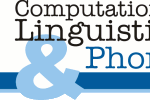The Phonetics of Laughter
My current project - funded by the Saarland University - deals with laughter occurring in conversations.But why study laughter?
Paralinguistic information in the acoustic communication channel is expressed by tone of voice,
simultaneous with the verbal content of utterances, but also by non-verbal vocalisations.
Although laughter is one of the most important universal non-verbal vocalisations
there are only a few studies performed by phoneticians on laughter.
Since researchers from many disciplines have worked in the field,
the terminology is heterogeneous and sometimes confusing.
The missing common inventory for describing phonetic events makes data comparisons difficult
and prevents the development of theories about the acoustic as well as the physiological and perceptual nature of laughter.
Examining the acoustic phonetic structure of a "typical" laugh reveals an alternating voiced-unvoiced pattern resembling a CV syllable structure (cf. the orthographic "haha" and "ahah") typically with an aspiration phase as consonant and a following vowel of varying quality. Depending on the study, the vocalic segment is named "pulse", "note", "call", "event", "burst" but also contrary to phonetic terminology "syllable" or even "plosive". The consonantal segment is often seen as "interval" or "pause" rather than an aspiratory phase. The joint CV unit is referred to as "cycle", "syllable" or "call", enlarging the pool of terms. The inhalations sometimes found during laughter are seen as separators of different "bouts", and it often remains unclear whether a single laugh is exactly one bout or can consist of two or more bouts. Moreover, the possible role of the inhalation phase with reverse phonation is usually ignored, although it is often strongly marked by a distinct increase in F0 and intensity.
In addition to "typical" laughter, speech-synchronous forms such as speech-laughs and smiling while speaking can be distinguished from genuine laughter as well as faked, spoken/sung, and pathological forms and laughter due to tickling. Among the spontaneous and emotional forms of laughter, different types have been identified according to voicing and place of friction (oral or nasal). Not all studies agree on their findings regarding parameters related to F0, vowel quality, intensity, and duration. One reason for this can be found in the lack of common definitions of units and types of laughter.
The talk addresses the mentioned methodological issues by inspecting data containing laughter. This evokes a further methodological problem: How can we elicit spontaneous laughter? The inspection of speech data recorded for other purposes reveals that laughter is much more complex than expected from the classes and descriptions proposed so far.
Laughter is a research subject for many disciplines including primatology, ethology, inter-cultural studies, medicine, neurobiology, speech technology, forensic phonetics, conversational analysis, developmental psychology, and particularly emotion research. Phonetics can definitely contribute to the research of this universal human pecularity of every-day communication.
Some references
Bachorowski, J.-A., Smoski, M.J. & Owren, M.J. (2001). The acoustic features of human laughter. Journal of the Acoustical Society America 111, pp. 1582-1597.
Bickley, C. & Hunnicutt, S. (1992). Acoustic analysis of laughter. Proc. Intern. Confer. of Spoken Language Processing ICSLP 92 Banff (2), pp. 927-930.
Nwokah, E.E., Hsu, H.-C., Davies, P. & Fogel, A. (1999): The integration of laughter and speech in vocal communication: a dynamic systems perspective. Journal of Speech, Language & Hearing Research 42, pp. 880-894.
Ruch, W. & Ekman, P. (2001): The expressive pattern of laughter. In: Kaszniak, W.A. (ed) Emotion, qualia, and consciousness. Word Scientific Publisher, Tokyo, pp. 426-443.
Tartter, V.C. (1980): Happy talk: Perceptual and acoustic effects of smiling on speech. Perception & Psychophysics 27 (1), pp. 24-27.
Trouvain, J. (2001): Phonetic aspects of "speech-laughs". Proc. Conference on Orality & Gestuality (Orage 2001) Aix-en-Provence, pp. 634-639.
Trouvain, J. (2003). Segmenting phonetic units in laughter. To appear in Proc. 15th Int. Congress of Phonetic Sciences.
Research Questions
It's difficult to elicit laughter in the lab. Annotated speech corpora of conversations provide an alternative in which laughter is recorded "by coincidence".How is laughter annotated in accessible (German) corpora of spontaneous speech (with annotation texts and speech signals)?
Laughter has not a uniform phonetic shape - there is rather a great repertoire of laughter.
What kind of phonetic realisations can we find in our corpora?
Since there is no standard terminology to denote laughter and parts of it - due to a lack of research interest and the involvement of many disciplines.
There is no common definition of laughs and its portions. Thus, the questions are:
What is a laugh - where does it start, wher does it end?
What types of laugh can we distinguish?
How shall we name the parts and features of a laugh?
We found many mild forms of laughter in our own corpus, apart from the observation of the many speech-laughs
which are often over-heard (or at least not annotated) or not considered real laughter.
Are mild laughs perceived as laughter when presented in isolation, i.e. without the preceding or following speech context, or is it just noise?
People normally laugh during social interaction, and they frequently laugh together.
But as mentioned earlier, a speech lab is not the best place to generate a spontaneous atmosphere,
and a further challenge to differentiate different speakers/laughers in the overlapping vocalisations in the recorded signals.
How can we elicit spontaneous laughter in good sound quality for each of multiple persons?
Audio examples "speech-laughs"
All examples are in wav-format.

